Christopher Hector talks with Christoph Hess
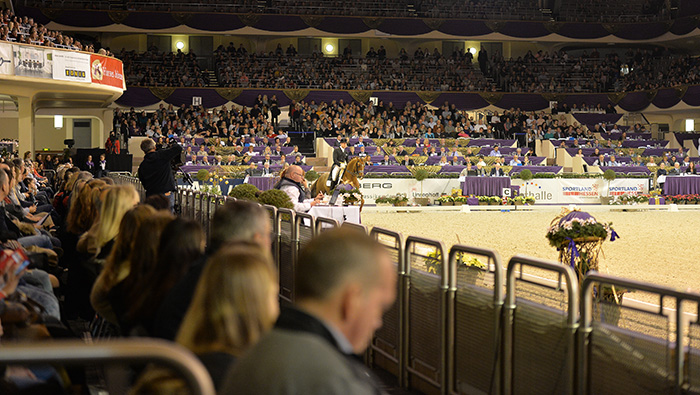
Frankfurt is one of my all-time favorite horse shows and one of the people who contributes to the amazing atmosphere is commentator extraordinaire, Christoph Hess. Christoph lights up the big indoor arena with his enthusiasm and his knowledge, deftly combining judging, training and communication skills in equal measure. It’s this enthusiasm combined with the knowledge that has made Christoph a compelling presence on both the dressage and eventing scenes around the world. Luckily I managed to get him to slow down long enough for this wide-ranging interview at Frankfurt in 2021 …
The highlight of the Frankfurt Horse show is the Nürnberger Burg-Pokal, a wonderful bridging competition devised by the late Reiner Klimke to help young talented horses as they moved into FEI tests. The competition has produced a who’s who of winners over its 27 years history, what did Christoph think of this edition?
Sadly the 2021 Frankfurt Show will be closed to spectators and journalists again this year…
“I think we saw good riding, good horses, some horses with the qualities to represent Germany – or other countries – in the Championships. I don’t think we had a top top top special horse, like we’ve had in previous years, where horses have scored more than 80%, but we had good results in the mid and high 70s.”
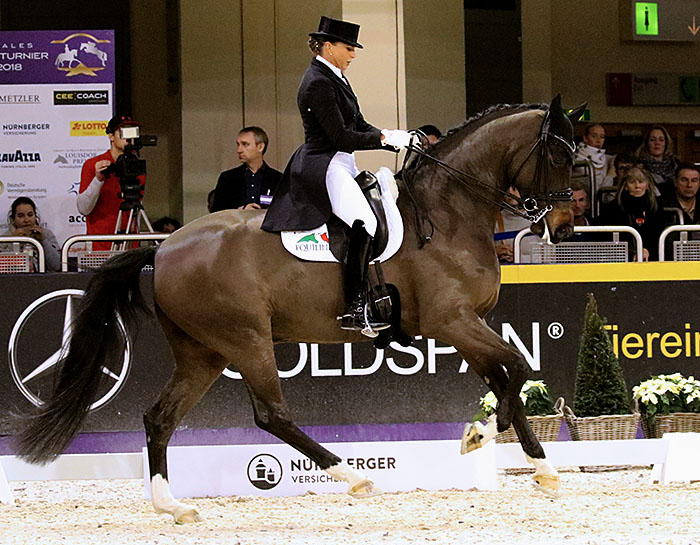
“But we had some really good horses, you only have to look to the winner, Dorothee Schneider. First Romance is an amazing horse in the whole trot work, lovely hind leg, real charisma, very attractive the minute it comes into the arena – but I would say just a little bit tense in the canter tour, therefore he was not able to get higher scores.
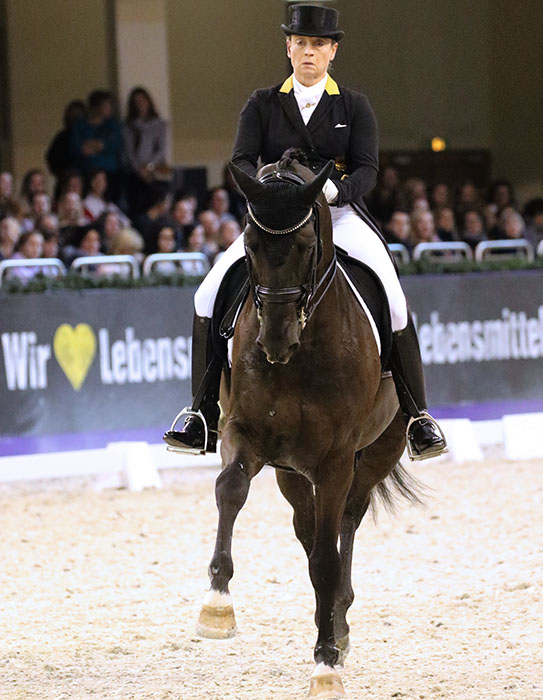
Isabell Werth did a really good job with Descolari, good trot, amazing walk. I think she had problems in the qualification round on the first day, but she did a really good job. I saw a little bit in the pirouettes that it was a little bit weak, but she was amazing to collect the horse, to ride it straight and do these movements, from the rider’s point of view, it was great. She made the horse, and the longer the test went on, the more confidence the horse had, and the more supple the horse was, and the better the rideability was.”
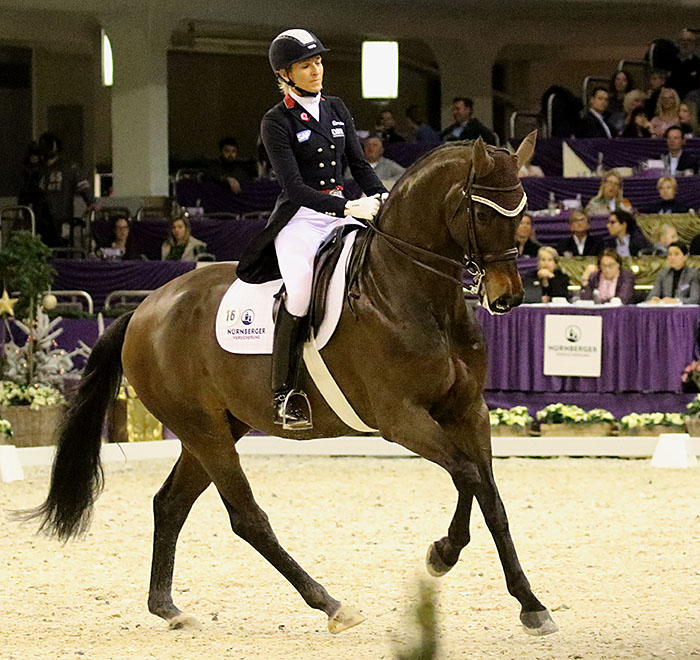
Ingrid Klimke and Bluetooth, “a serious horse, very well trained.”
“The third horse, Ingrid Klimke and Bluetooth, it’s not a fascinating horse – you see other horses that have more potential for swinging, moving and elasticity, but it is a very serious horse, very well trained, good halt – the first halt was nearly a nine, no mistakes. The only problem was, the walk was weak. In the collected walk between the pirouettes, it is a special movement with a coefficient of two, and then you get it in the collected marks as well, therefore she lost a lot of good marks for the walk, and the walk in this level is very difficult. When you are at the Grand Prix level, then you have just a little bit of walk and no walk pirouettes. In this test, the walk and the pirouettes are very difficult and therefore it was correct that she didn’t come to a higher score.”
Do we care that the horse swished its tail?
“I saw it, it was mainly in the walk, and the canter, not in the trot, but it was worse in the collected walk than in the second part of the test, this is what I saw.”
The walk pirouette, a boring bit? Hubertus Schmidt demonstrates…
We saw in the Nürnberger Burg-Pokal, how crucial the walk pirouette was in showing the quality of the horse and the training, and yet we have this push from the FEI to get rid of all the ‘boring bits’ like the walk pirouette, is this the slippery slide to hell?
“I agree 100%, but first of all I have to say that I would like that we have more than one Grand Prix test, but I think that it is very important that we have all these movements so the judges can see, is the horse trained in the right direction, yes or no? At the end of the day, if we just have movements on the straight, medium or extensions in walk, trot, canter, piaffe and passage, it is not a Grand Prix.”
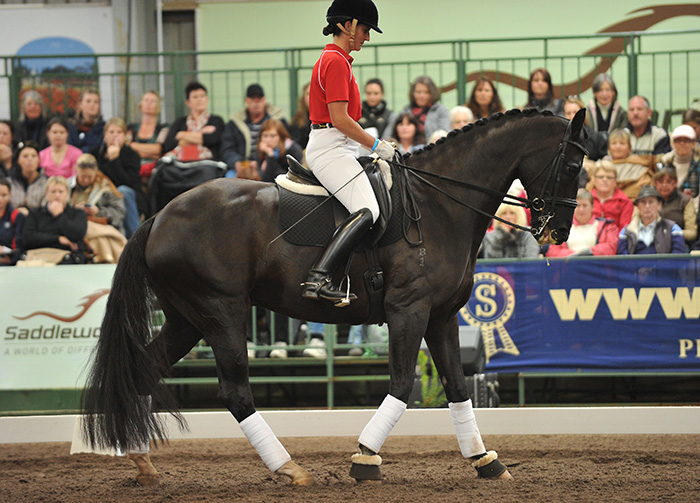
The rein back, should be back in the test
“I think you are right, we need the pirouette in walk, maybe only one pirouette, we need rein back at least, or schaukel (see below) which is much better, which is much more of a challenge, and one movement that I know no-one likes, but flying change in medium canter, and one more thing, I like it very much if during the test, maybe on a circle line, you give the reins. I think we should see that suppleness is more important than three times piaffe, I think two times is enough, with transitions – I love it, we need it, but I think we need the basic things as well.”
The Schaukel, the word means swing in English, it was movement no. 7 in the Grand Prix test at one time.

“Another thing I like very much is in the extended trot and canter, is to give the reins, and re-take the reins, so you see that the self carriage is there, the good riders I am sure they have no problems, but it would bring the not-so-good riders into the right direction in their training.”
“At Aachen this year, for instance, we had problems in the warm up arena, people came and took pictures for the social media which created a bad picture, but I am sure that if we changed the test to have these movements then there will not be so many bad pictures because the riders will ride a little bit in another way, because the test they ride at the competition is what the riders have to train at home, and train in the practice arena.”
There are riders who scream ‘oh it was just an unlucky moment!’ – how is it that the good riders like Carl and Charlotte, Helen and Katrina and Hubertus, don’t ever have ‘unlucky’ moments, and the same riders have ‘unlucky’ moments at show after show after show – good riders don’t do ugly things…
“Exactly. I agree, and I think spectators have a very sensitive feeling of what is good, what is harmonious? Okay, horses make mistakes, riders make mistakes, mistakes will always happen, but what the spectators want to see is harmonious pictures and well-trained horses. I think someone who has no equestrian knowledge very quickly has the feeling, was the horse and rider trained in the right direction? Or is it a fight between the horse and the rider? Is it something with tension? You see it with the tail, you see it with the ears, the mouth is open, the horse looks unhappy – and everyone can see this, it is something we can explain very easily even to someone with no knowledge of horses.”
Today, I was standing out the back watching Kira Wulferding warm in one of her horses and I thought this was worth 30 hours travel just to see how beautiful a warmup can be with a wonderful rider and a beautifully trained horse… There could have been a thousand people videoing on their mobile phones and they wouldn’t have found one frame they could use on the social media to criticise the rider…
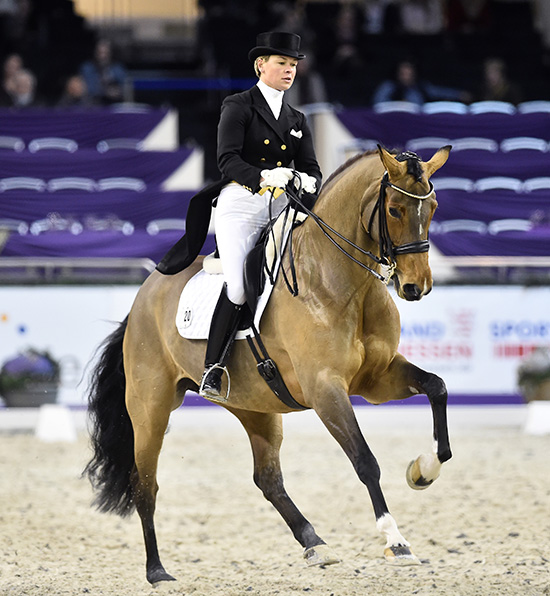
Kira and Brianna, a good example
“I agree 100%, and Kira is a good example, she can ride during the test with a long rein, she can give the rein, re-take the rein. When she had finished her test, I said that I loved to watch her, and I could watch her every day, every minute, because I love the way she trains her horse.”
“I look from the judges’ point of view and from the trainers’ point of view. The judge needs enough key points to see if the horse is trained in the right direction. If you don’t have these key points, then at the end of the day, you only look how is the piaffe, how is the passage? How was the extended walk, how was the extended trot? How was the extended canter, and maybe, how were the pirouettes? And are there mistakes in the flying changes? This is very easy and at the end of the day, we don’t need judges, we can have a computer…”
And the spectators…
“Yes, and the computer and spectators, but to judge in a serious way, we need these basic things to see if the horse is trained in the right direction, is the horse and rider really in harmony? We need all those movements to come to a serious result.”
It is interesting that here at Frankfurt show, the opposite approach is working… instead of dumbing down the test, you educate the audience. You have a nice test rider in the arena, and you are on the mike explaining the movements, then you comment on the test, and the rider is interviewed at the end of the test by a top journalist, and a judge…

“This is exactly what I think as well. The first years I was judging the Nürnberger Burg-Pokal in the 90’s, and later, Holger Schmezer, who was then the team trainer, asked me to come and do the commentary. I started when Reiner Klimke was commentating, then Holger Schmezer was commentating, then I took the job. The Nürnberger Burg-Pokal is now 27 years old, and in the 90’s, in the beginning, it was a lovely test, it was a lovely competition, but a long way from the atmosphere we have now. We have music now, for walk, trot, canter, we have wonderful decoration in the indoor and I think, a little bit, maybe, 1% because of the commentating – to explain what is going on, I don’t know what the scores are, I don’t look into the computer, I give my own comments, but I think this is good for education, the spectators learn to judge themselves.”
“I think I look at it from both angles, the judges’ point of view, but also the trainers’, and therefore I try to bring everything into balance.”
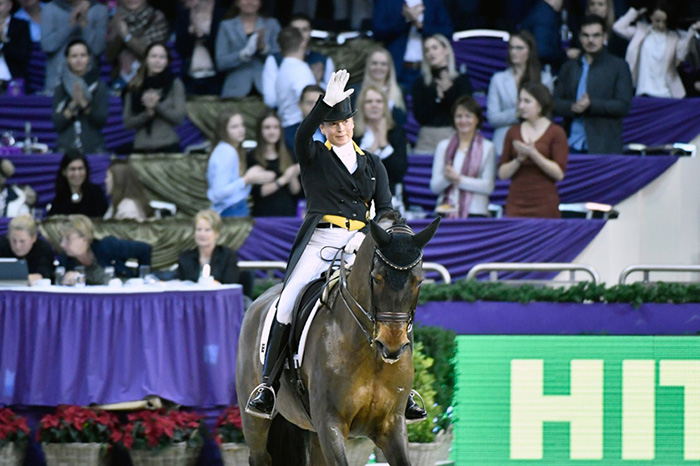
After her final (winning! Score 82.845) performance on Don Johnson FRH in the Freestyle at Frankfurt, Isabell was all aglow reflecting on Johnny’s career that spanned nine years at the Grand Prix level.
I thought the spectators were really interesting in the Grand Prix. Their favorite, Isabell Werth had done her test on Don Johnson, then the very next horse to come out was Zepter with Daniel Bachmann, and the spectators immediately appreciated how good the test was and really applauded even though it was going to beat their favorite’s test… This is a crowd with such an educated eye.
“In dressage we are not soccer or showjumping. In soccer it is a goal, or not a goal, showjumping, a mistake or not a mistake. That’s very easy to understand, but dressage is very difficult to understand, and that is why what we have to do, is educate the people, then they love it. When you understand, it is so relaxing to watch a competition, it’s almost like being in church, a feeling of harmony, and for me it is very important to give this feeling to the spectators. Each year at Frankfurt we get more and more spectators, and now it’s full houses, sold out. And it was not like this in the beginning, but it has grown, and I think that is a little bit because of the comments, first Reiner Klimke, then Holger Schmezer, then me – it is an honour to have this job, but it is also a big responsibility, to say nice words, but also to be honest and not say everything is good, good, good. When you say what is not good, you have to put it into sentences in a nice way.”
I can remember you saying that you thought young horse classes might lead the way out because there would be more concentration on the basics, on the natural movement. But do we have to take care to produce horses that go naturally in those classes as well?
“I think we have to be careful. I think a good example was the five-year-old class at the World Young Horse Championships at Ermelo. I was not judging the five-year-old class, I was judging the final of the seven years, but in the five year olds I was giving comments, just for the last five or six horses for ClipMyHorse.”
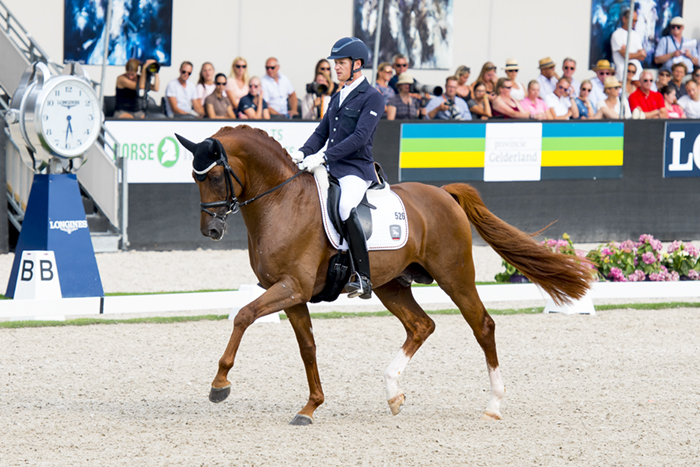
Matthias and Destacado © DigiShots
“This was a good example. We had Matthias Rath riding this lovely chestnut, Destacado (Desperados / Londonderry) and Andreas Helgstrand riding Revolution (Rocky Lee / Rouletto). The chestnut was ridden in the way we want to see horses ridden on this level. Andreas – and I spoke with him about this at the Bundeschampionate a couple of weeks later – was asking for more than an extended trot, trying to get a 10.0! I said, Andreas, it is medium trot and medium trot is not extended trot. The judges say if it is not covering ground, or not in rhythm, they give low marks, but if it is not medium trot…? They say, oh, that was the best trot I have ever seen. I think it is very important to explain to the riders that medium trot is medium trot and not extended trot…”
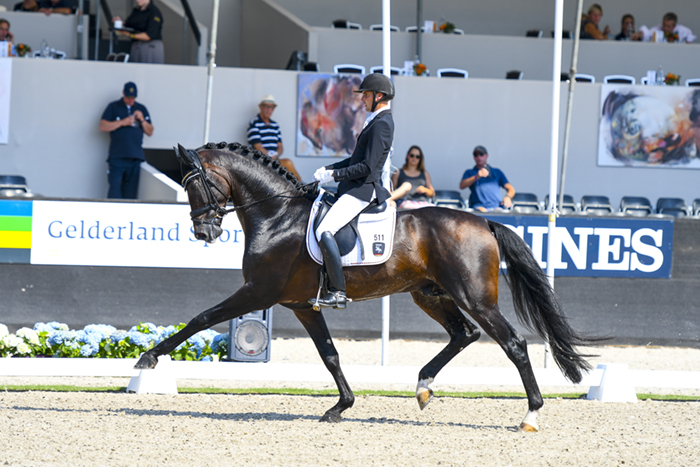
Andreas and Revolution © DigiShots
And explain that to the judges…
“Yes, okay, I am one of them, but I think that is very important too, before the next World Young Horse championships, we explain what we want to see. In the five-year-old class, we have only medium walk, no extended walk, we have medium trot and medium canter, no extensions, which is good from the training point of view. But then Andreas said to me, Christoph, why don’t we ask for extension? And I said, extension is too much for a five-year-old. In the olden days, they said the four-year-old horse was a young remount, and the five-year-old horse an older remount – a remount is like a child in the primary school.”
“But instead of being in the primary school, now the young horses look like Grand Prix horses, and at the end of the day, we work against the nature of the horse. It is very important to explain to all people who are involved with young horses that they train young horses, they judge young horses, and they compete young horses on the level of their age.”
“For the five-year-old, just medium, no extension, only some extension in the six-year-old class. It’s not that the judges should look for ‘the best’, which horse brings his legs as high as possible. In the old days at the Bundeschampionate, we had the same problem, horses were jumping half a metre higher than the fence was. I think in the old days, the judges had given these horses big marks, that’s a super jumper, then we said, no that is not a natural jump, we want horses that jump economically. Jumping too high is not good for the body, not good for when they are older because they are always too slow.”
“It is so important that we stress this: medium walk, medium trot, medium canter for the five-year-olds, this is the lesson we must learn from these young horses.”
I think it always comes back to rhythm, and rhythm is the horse’s defense, tense horses are never rhythmic, these spectacular horses are always go, go, slow, go, go, slow, they quickly lose their natural rhythm – it worries me that the judges are not looking hard enough, how pure, how natural, is this rhythm…
“I think it is very important from the judges’ point of view, that we have to look at the natural movements. We want to see first the natural movements, and with the natural movements the goal is more perfect, more elastic, but the first step is a natural movement not an artificial movement. But I think this not so natural movement is not just from Andreas’ stables…”
Giving the reins is very important…
“That is why for me these movements like giving reins are very important, giving rein and re-taking, long reins, and I think when we do new tests for young horses, it is better to do this more in the beginning of the test. Now we have long reins at the end of a test, but I think it would be better at the beginning, or in the middle of the test. Now they do everything, then they give the reins for a short moment and then they finish, this is better than nothing, but it is better for the judges if they see this during the test. We have a national test for five and six-year-old horses, half pass left, then a circle long rein, then shorten the reins, then half pass right, then they continue the test – then you see if the horse is trained in the right direction, or, are there difficulties. This is the direction in which we should be thinking, but in general, and I have judged in Ermelo the last three years, in general, I think with the young horses we are on a good way. We see a lot of really really good riding. For me, this is one of the most important parts of the dressage world because the judge can give explanations to spectators, riders and trainers – this is what we want to see.”
Many top stallions are available in Australia this season from: www.ihb.com.au
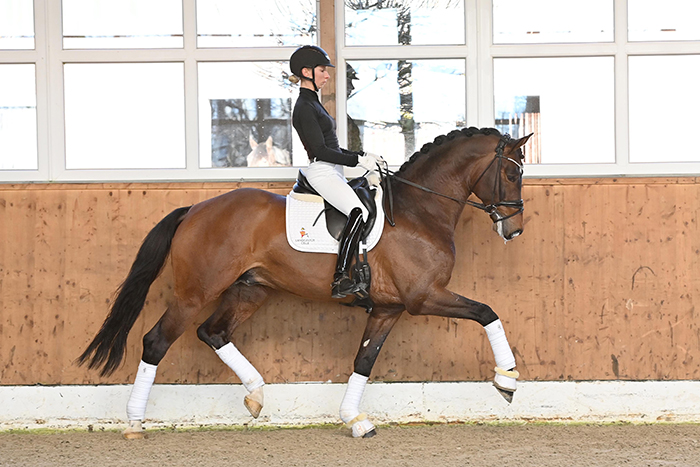

Revolution


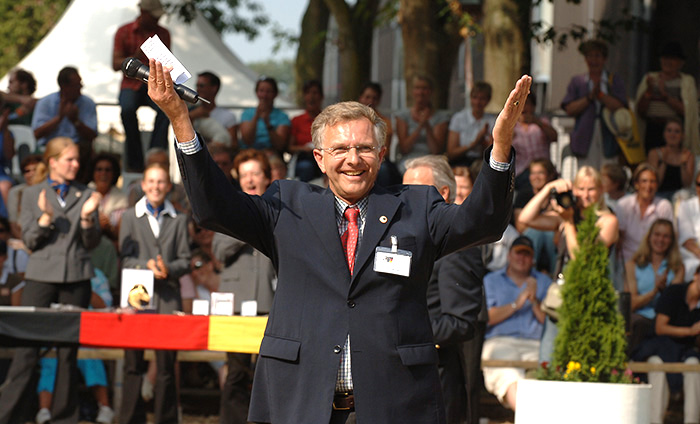
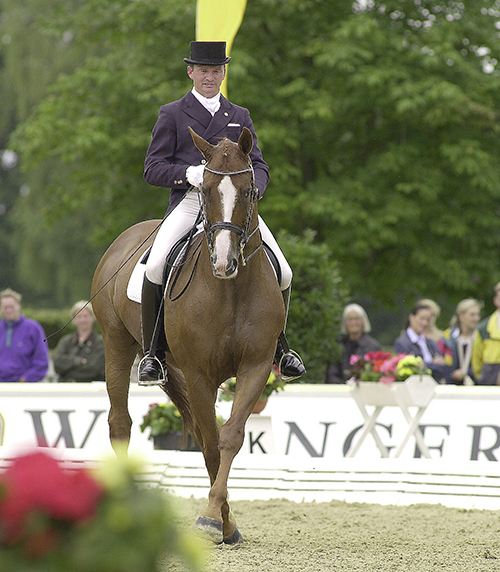
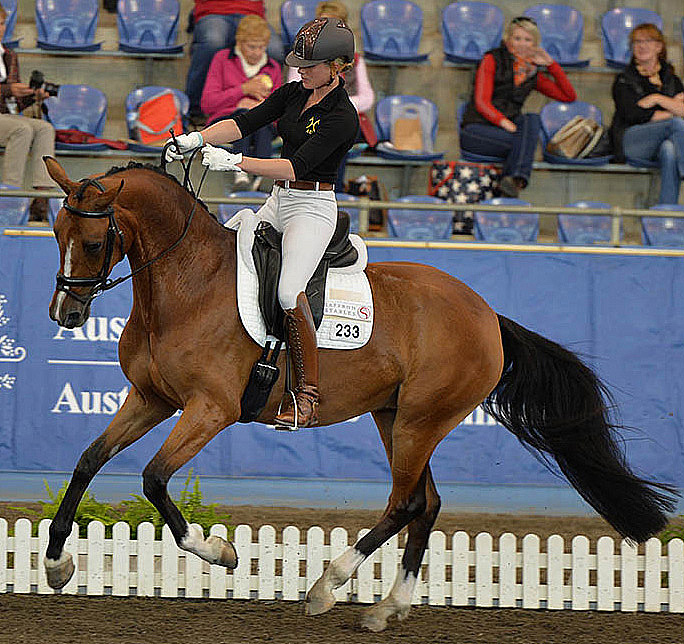
Good reading!
Very good reading!
So very, very true, is it not, that young horse classes ought to be judged on what a horse of that age might be expected to display and that perhaps the rider ought to be penalised by judges for riding the horse above that level. Might I also say that it would do dressage in general, and in Australia and new Zealand in particular, if commentary, informed commentary, were a more common and regular feature of dressage shows? Perhaps then you’d get actual spectators turning up! Wouldn’t that be something!